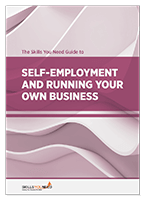How to Be a Full-Time Freelance Designer
Top Tips on FreelancingThe Covid-19 pandemic has resulted in the loss of many jobs across the world. As a result, the gig economy expanded exponentially in 2020 and many people resorted to freelancing instead of working in a regular job.
A word of caution, though. Although freelancing might appear to be a glittery job - no boss looking over your shoulder at the end of every shift, no colleagues to fight over promotion and resources – it is not always easy. Freelancing is like owning a business and, unless you have the necessary skills to maintain your business, you may go off course.
Designers are probably some of those most suited to a freelancing career. The output-based-world of design - be it graphic, interior, or website design - has made it one of the most popular freelancing careers.
However, this makes securing work and clients difficult as you are competing with hundreds of other designers that are on your level, if not better than you.
Not that I’m discouraging you in any way, but, if you want to be a full-time freelancer, you’ll have to work on the basics - the foundations - to help you attract prospects and develop a sustainable career.
We know stories of people who, from freelancing, went back to a full-time job. We’ve heard people balancing both freelance and full-time, working tirelessly on different projects after work hours or during weekends. We can also find stories online of freelancers who became so successful they are earning six figures from their gig alone.
It could be strategy or sheer luck. But here I lay out some essential steps that successful freelancers took in the early stages of their careers:
Be a Staff Designer
First, you need to build your skills. If you are sufficiently skilled, you can skip this step but, for newbies planning to jump into the gig economy, you must hone your craft. And what a better way to do it than get involved in the process. At least from the beginning, be a sponge that absorbs everything from your superiors and colleagues.
Working as a staff designer is a good training ground. You work with co-designers who will, in some way, help you to improve your skills. You have accountability partners and work critiques. Plus, it’s an excellent opportunity to see what is missing in other’s output, what is unique in your craft, and how your abilities can contribute to better results for your future clients.
Compile Your Portfolio
As soon as you start your first project, document your work process: before and after. Documentation provides strong evidence of your abilities and work ethic. Also, most clients ask freelancers for their portfolios. It’s kind of a requirement.
Document every single project - even ones that failed or had insignificant results. Monitor your progress. See how you have improved, what unique abilities you have gained, or what kind of expensive skill you have acquired.
Finally, compile your output in a well-designed website that showcases your abilities, creativity, and uniqueness.
Pro tip: ask your previous bosses or superiors for some words of recommendation. You can use those as quotations on your website and LinkedIn profile.
Establish Your Website
Your website will be the facade of your freelancing business. It must include your personal story, contact details, and, of course, your projects.
Suppose you don’t have a website yet. Start planning the layout. What kind of information do you wish your clients to see first? In short, what kind of flow of information will be available once someone visits your website. You can choose from the pre-designed templates of free web hosting services, or you can design from scratch if you have the experience.
After the layout, determine your brand. The brand includes logo design, color palette, messaging, visuals - overall, the feel of your freelancing enterprise. Make sure the branding resonates with your goals and visions.
Join Freelancing Sites
Both newbie and seasoned designers use freelancing sites to find work. For logo designers, you can hop on DesignCrowd and make good money selling your designs. Also, try Upwork and Fiverr for any type of freelancing services like content and copywriting, website designs, tarpaulin layouts, etc.
While it’s easy to join in most freelance platforms, the catch is that they’re mostly very saturated. Sure, loads of clients flock to the sites, and you can find and pitch to them instantly, but you are likely to be competing with hundreds of co-freelancers. Apart from that, the pay is relatively small.
When I started out freelancing, I used these accounts to find immediate clients. For the most part, it worked well, but I could only ask for small commissions due to very tight competition.
The best thing, however, was the training it provided. Most clients were professional to work with, they laid out precise details of the job, and they were mainly satisfied with my output.
Start Pitching
If you want to grow your freelancing into a full-time career with a legit full-time income, start cold pitching.
You won’t get far in freelancing without reaching out to clients. However how you do this will vary from person to person. You could search for new business ventures that may need the help of designers. Or you could try emailing websites in your niche and ask if they would be interested in your services.
LinkedIn can be a good source of business contacts. Find out as many details as you can about the company – especially their problems. Then offer your help. Make the correspondence as friendly and as professional as possible. This may be best done through calls. Finally, submit your portfolio and enthrall them with your designs.
Email pitching is excellent too. Look up websites and people looking for freelance designers. Scrape their contact details, then start your email outreach. Start with your greetings, state their problems, and what solutions you can offer. If there is no response after a week, following up is vital.
Continue Networking
Freelancing is a marathon. It’s a journey that might seem endless. To become successful, consider every step as a networking opportunity.
Just closed the deal with that San Francisco start-up? Once finished with the project, ask for referrals. Business owners are good networkers themselves. They know a wealth of contacts and opportunities that you might not have the resources to access.
Optimize your networking channels as you go along. Tweak your websites here and there—update contacts, projects, author bio, etc. Don’t forget your social networking accounts. Make sure they’re as close to a designer profile would be.
Further Reading from Skills You Need
The Skills You Need Guide to Self-Employment and
Running Your Own Business
If you are thinking about running your own business, or already do so, but feel that you need some guidance, then this eBook is for you. It takes you through self-employment in easy steps, helping you to ensure that your business has more chance of success.
The Skills You Need Guide to Self-Employment and Running Your Own Business is the guide no new or aspiring entrepreneur can afford to be without!
Based on our popular self-employment and entrepreneurship content.
Final Thoughts
There’s a reason why freelancing makes up the minority of the workforce. It’s difficult to sustain yourself with a meager source of income from the start. You have to endure countless rejections and minimum payments.
But those are good steppingstones to acquiring valuable skills. Be open to learning everything you can about your industry. Once rooted, you can start asking for higher payments and even rejecting some untrustworthy and low-balling clients.
About the Author

Clancy Clarke leads BrandCrowd and DesignCrowd's marketing and analytics functions. With over 15 years of digital marketing experience, Clancy is still out to learn and help drive growth!
Previously, Clancy was the online marketing manager at a leading Australian web hosting company. Clancy holds a Bachelor of Engineering from the University of New South Wales.


